 The Degree of Privacy Requirement for Residents’ Activities in the Shophouse in Yogyakarta
The Degree of Privacy Requirement for Residents’ Activities in the Shophouse in Yogyakarta |
<Journal of Habitat Engineering and Design, Volume 5, Number 1, pp. 113-125, Mar. 2013>
Lya Dewi Anggraini, Ryuzo Ohno |
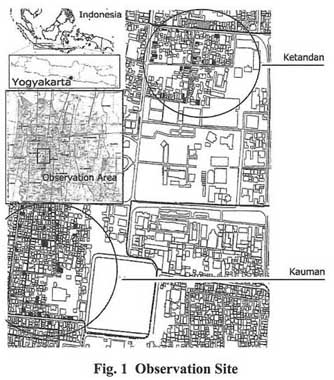 |
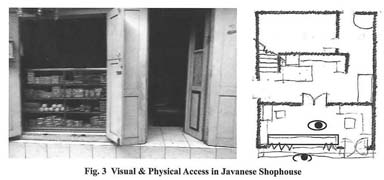 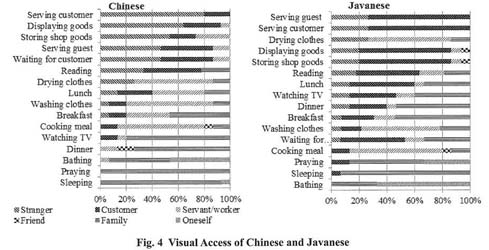 |
Residents of shophouse in Yogyakarta combine shop keeping with domestic activities
which require different degree of privacy related to social interaction. Intensive observation and in-depth interviews were conducted with 30
residents to obtain their daily activities and to inquire how they feel invaded with such category of people as strangers, customers, servants/workers,
friends, and family members visually and physically. The difference of privacy requirement between groups and individuals is examined by contrasting
two communities in Chinese and Javanese settlements. There are selected 16 activities which are sorted out from low to high degree of privacy
based on the accumulated response in each category of people. The result shows that 4 activities (serving guest, serving customers, displaying goods, and storing shop goods)
require low privacy, 9 activities (waiting for customers, drying clothes, reading, lunch, washing clothes, breakfast, watching TV, dinner, and cooking meal)
require moderate privacy, and 3 activities (praying. sleeping, and bathing) require high privacy. Further result shows that the physical and visual requirement
are highly correlated or much higher in physical access than visual access for all activities for both groups but such activities as cooking meal, washing clothes,
drying clothes, and serving guest for several residents require higher visual access.
Full paper → PDF |
|
 Study of Indonesian Social Behavior through Activity Pattern Analysis in
the Dwellings Study of Indonesian Social Behavior through Activity Pattern Analysis in
the Dwellings |
<Proceedings of AIJ annual conference (E-1) pp.335-336,August 2009>
Syam Rachma Marcillia and Ryuzo Ohno |
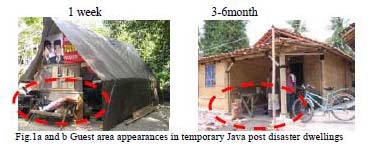 |
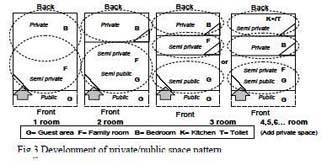 |
As a dwelling, the house is not merely a shelter; it is an actualization
of meaning. Objectives of this study are;
To know whether social behavior is really an important aspect of Indonesian
dwellings in any circumstances, what are the fundamental meaning, ideals
or values of Indonesian social behavior that need to be facilitate and
how is it facilitated through the spaces and activities arrangements in
the dwellings.
Constraint dwellings are chosen as research objects to extract a clearer
relation between social behaviors with dwellings usage. Residents’ activities
were investigated by studying spatial development and adjustment for satisfying
social interaction in Java earthquake 2006 post disaster dwellings and
studying behavioral adjustment of conflict for need of privacy and social
interaction in mis-fit and unchangeable spaces of Japanese compact apartments.
Questionnaires and interview were conducted in both case studies. Information
on respondents’ background, house plan, personal and interpersonal activities
and cognition of spaces were achieved. As results, it is necessary even
in constraint dwelling to consider social behavior importance as culturally
sensitive design for reconstruction recovery.
Full paper → PDF |
|
|
 Indonesian Family Living in Japanese Compact Apartment -Definition of
Spaces and Privacy Gradient- Indonesian Family Living in Japanese Compact Apartment -Definition of
Spaces and Privacy Gradient-
|
|
<Proceedings of AIJ annual conference (E-1) pp.775-776,September 2008>
Syam Rachma Marcillia and Ryuzo Ohno
|
|
In defining dwelling (housing), one can not only compare the physical artifacts
encounters (Rapoport, 2005). Different culture had different perception
and actualization of their dwelling. Such culture perceived ‘core house’
as their dwelling setting while other conceived not only the house but
also its surroundings streets shared wheels, religious institution, etc.,
that cannot be parted from their daily lifestyle as the dwelling settings.
Nowadays, Japanese compact apartment have more functionally separation
room compared to the traditionally large living room expressed as i-ma
or living "space", but basically it still provides ‘core house`
as the basic dwelling for Japanese culture. For the foreigners, sudden
change from self satisfied house at hometown country to Japanese compact
apartment had left no choice than to adapt to the condition. The limited
domestic space will increase the space and activities incompatibility and
although the physical setting had changed, cultural background inherited
from previous living environment continuously adapted to the limited Japanese
compact apartment. This will lead to compensation between space and activities
that involves space-activities regulation. This paper discusses a preliminary
research to understand how people from different culture adapt and cope
with the constraint living.
|
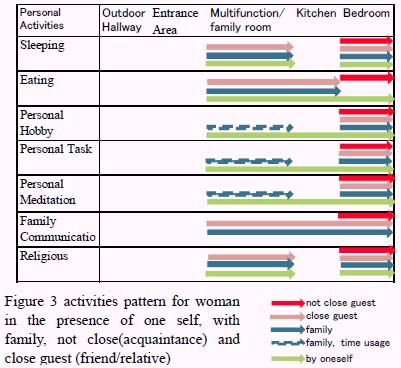 |
Full paper -> PDF
TOPへ
|
|
|
|